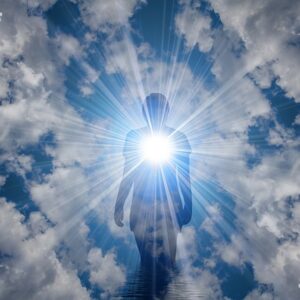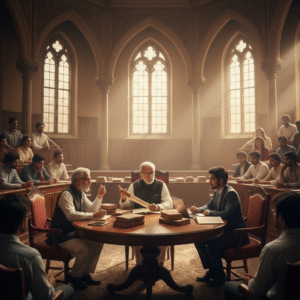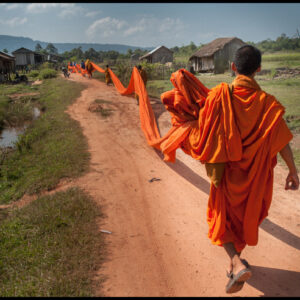The Hindu divine triad, comprising Brahma (the Creator), Vishnu (the Preserver), and Shiva (the Destroyer), forms the cornerstone of Hindu cosmology. These three deities represent the cyclical nature of the universe: creation, preservation, and dissolution, which together sustain cosmic balance. But where are these figures mentioned in Hindu scriptures, and how do their roles evolve across texts?
Vedas: The Foundations of Hindu Thought
The earliest mentions of Shiva, Vishnu, and Brahma can be traced to the Vedas, though their roles and identities are not as distinct as in later texts.
- Rudra (Shiva): In the Rigveda, Rudra is a storm deity associated with destruction and healing, an early form of Shiva. Hymns like the Shatarudriya in the Yajurveda portray him as a powerful, ambivalent force. Over time, Rudra evolved into the benevolent and transformative figure of Shiva, known as Mahadeva (Great God).
- Vishnu: Vishnu is referenced in the Rigveda as a solar deity associated with the cosmic order. He is praised for his three strides (Trivikrama), symbolizing his vast reach and connection to the universe. These references foreshadow his later role as the Preserver.
- Brahma: The Vedas do not explicitly mention Brahma as a creator deity. Instead, the concept of creation is tied to Prajapati (Lord of Beings) and the primordial sacrifice (Purusha Sukta), which describes the cosmic being whose dismemberment gives rise to the universe. Brahma’s identity as the Creator emerges more clearly in the Puranas.
Upanishads: Philosophical Elaboration
The Upanishads, focusing on metaphysical and spiritual knowledge, mention the triad symbolically rather than theologically.
- Brahman: The Supreme Reality (Brahman) is described as the source and essence of all creation. While Brahma, Vishnu, and Shiva are not named explicitly, their functions are attributed to the workings of Brahman, emphasizing unity over individuality.
TheShvetashvatara Upanishadintroduces Shiva in a more personal form as Rudra, linking him to the concept of universal consciousness. Vishnu’s qualities of preservation and sustenance are associated with Brahman’s protective aspect.
Puranas: Defining the Divine Roles
The Puranas, composed between 300 CE and 1500 CE, provide the most detailed accounts of the triad’s roles and relationships.
- Brahma: The Puranas, such as the Brahmanda Purana and Vishnu Purana, describe Brahma as emerging from a lotus that grows from Vishnu’s navel, symbolizing the Creator’s dependency on the Sustainer. Brahma’s role is limited to creation, and he is less worshipped compared to Vishnu and Shiva.
- Vishnu: The Vishnu Purana and Bhagavata Purana exalt Vishnu as the protector of the universe, highlighting his avatars like Krishna and Rama. These texts emphasize his role in upholding dharma (righteousness).
- Shiva: The Shiva Purana and Linga Purana portray Shiva as the cosmic destroyer and ascetic, representing transformation and liberation. His duality as both destroyer and compassionate protector is a central theme.
ThePadma PuranaandSkanda Puranaelaborate on the triad’s complementary functions, stressing their unity in maintaining cosmic order.
Epics: Symbolism in the Mahabharata and Ramayana
- In the Mahabharata, Krishna (an avatar of Vishnu) is a central figure, emphasizing his role as the Preserver. The text also depicts Shiva as an ally of the Pandavas, underscoring his transformative power. Brahma appears in mythological narratives but is less prominent.
- In the Ramayana, Vishnu’s avatar Rama embodies dharma and protection. Shiva is venerated as a divine force, while Brahma is referenced in the context of creation.
Later Texts and Sectarian Perspectives
Over time, sectarian movements emphasized one deity over the others:
- Shaivism: Worships Shiva as the Supreme Reality, transcending the triad.
- Vaishnavism: Reveres Vishnu and his avatars as the ultimate divine force.
- Shaktism: Centers on Devi (the Goddess), often integrating the triad as her manifestations.
Brahma, by contrast, became less prominent due to limited worship practices and the rise of sectarian devotion to Vishnu and Shiva.
Conclusion
Shiva, Vishnu, and Brahma are woven into Hinduism’s textual and philosophical fabric, with their mentions evolving from the abstract hymns of the Vedas to the richly detailed narratives of the Puranas. While they embody distinct cosmic functions, their unity symbolizes the interconnectedness of creation, preservation, and transformation—principles central to Hindu cosmology and spirituality. As their stories continue to inspire, they remain timeless archetypes of divine purpose in an ever-changing universe.











